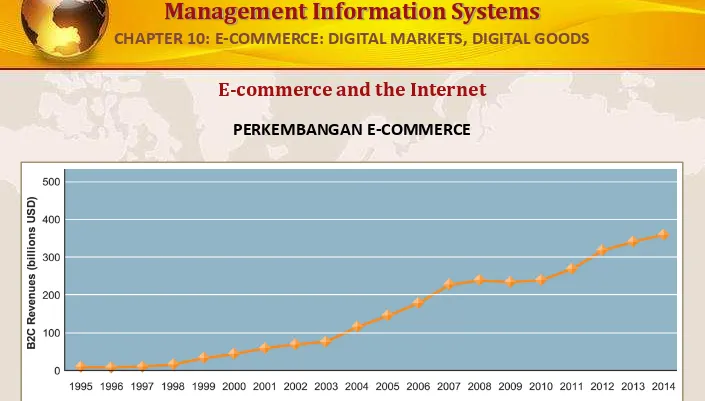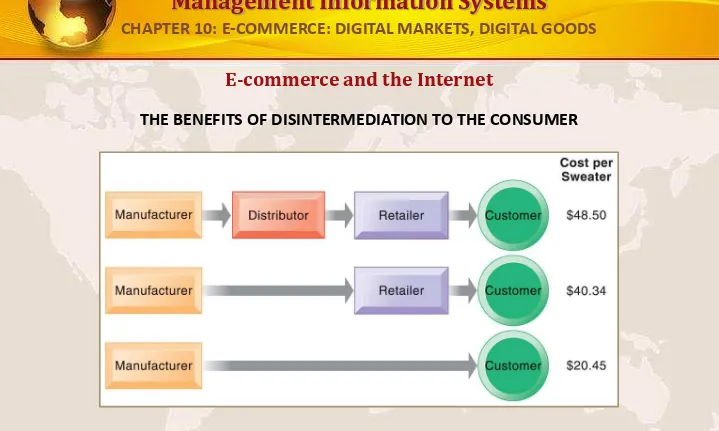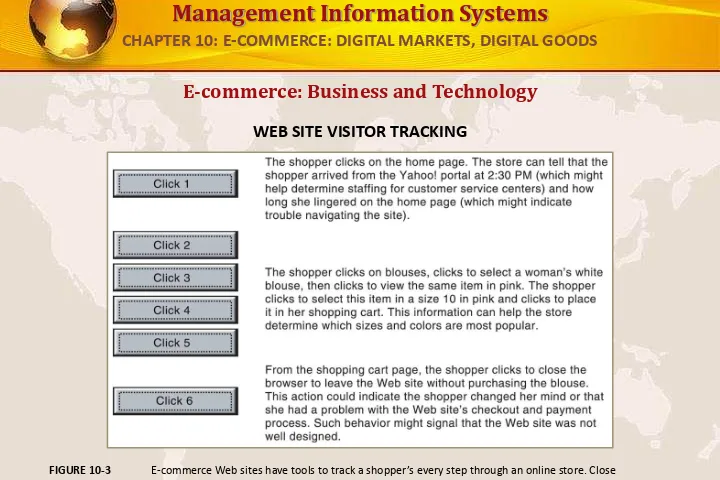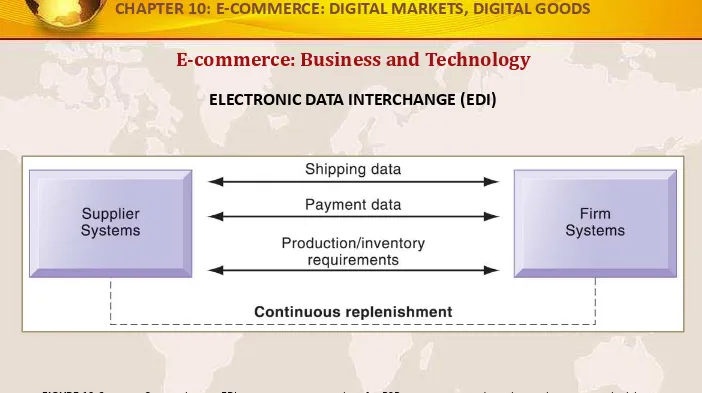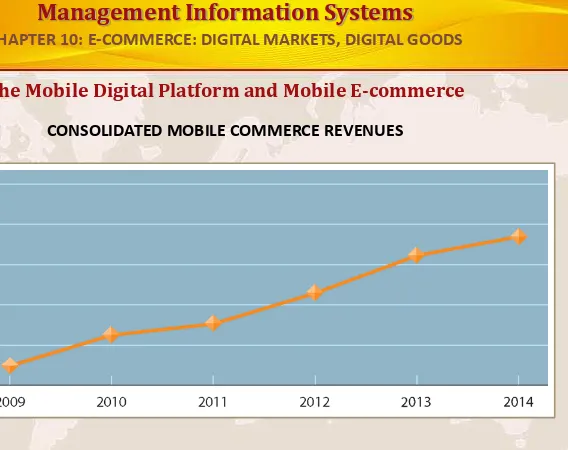Management Information Systems
MANAGING THE DIGITAL FIRM, 12THEDITION
E-COMMERCE: PASAR DIGITAL,
BARANG DIGITAL
Chapter 10
VIDEO CASES
Management Information Systems
• Apa saja fitur unik dari e-commerce, pasar digital, dan barang-barang digital?
• Apa e-commerce bisnis dan pendapatan model utama? • Bagaimana e-commerce berubah pemasaran?
• Bagaimana e-commerce yang terkena dampak transaksi bisnis-to-business?
• Apa peran commerce dalam bisnis dan apa aplikasi m-commerce yang paling penting?
• Isu apa yang harus diatasi ketika membangun sebuah e-commerce situs Web?
Learning Objectives
Management Information Systems
•
Problem
- Bedakan layanan restoran burger di
pasar yang penuh sesak (Manhattan)
•
Solution
–
Memanfaatkan jaringan sosial dan
crowdsourcing untuk pemasaran dan jasa
– Pemesanan via iPad, secara online
– Pelanggan dapat membuat dan nama sendiri sandwich
– Twitter, Facebook, Foursquare integrasi
•
Menggambarkan
:
Penggunaan sistem informasi
untuk menciptakan produk dan layanan baru
•
Menunjukan:
Penggunaan teknologi jaringan sosial
sebagai alat pemasaran
4FOOD: Burgers Go Social
CHAPTER 10: E-COMMERCE: DIGITAL MARKETS, DIGITAL GOODS
Management Information Systems
•
E-commerce saat ini:
–
Penggunaan Internet dan Web untuk transaksi
bisnis, digital memungkinkan terjadinya transaksi
–
Dimulai pada tahun 1995 dan tumbuh secara
eksponensial, masih tumbuh bahkan dalam
resesi
–
Perusahaan yang selamat dari Gelembung
dot-com (
dot-com bubble) meledak dan sekarang
berkembang
E-commerce and the Internet
Management Information Systems
E-commerce and the Internet
PERKEMBANGAN E-COMMERCE
Pendapatan e-commerce ritel tumbuh 15-25 persen per tahun sampai resesi 2008-2009, ketika mereka melambat terukur. Pada tahun 2010, pendapatan e-commerce tumbuh lagi di diperkirakan 12 persen per tahun.
FIGURE 10-1
CHAPTER 10: E-COMMERCE: DIGITAL MARKETS, DIGITAL GOODS
Management Information Systems
•
Mengapa e-commerce berbeda - 8 fitur unik
1. Ubiquity
•
Teknologi internet / web yang tersedia di
mana-mana: kerja, rumah, dll, kapan saja.
•
Effect:
– Marketplace dihapus dari temporal, lokasi geografis
u tuk e jadi " arketspa e”
– Kenyamanan pelanggan ditingkatkan dan biaya belanja dikurangi
E-commerce and the Internet
Management Information Systems
•
8 fitur unik (cont.)
2. Jangkauan global
•
Teknologi ini mencapai melintasi batas-batas
nasional, mengelilingi bumi
•
Effect:
– Commerce diaktifkan melintasi batas-batas budaya dan nasional mulus dan tanpa modifikasi
– Marketspace meliputi, berpotensi, miliaran konsumen dan jutaan bisnis di seluruh dunia
E-commerce and the Internet
CHAPTER 10: E-COMMERCE: DIGITAL MARKETS, DIGITAL GOODS
Management Information Systems
•
8 unique features (cont.)
3. Universal standards
•
Satu set standar teknologi: standar Internet
•
Effect:
– Sistem komputer yang berbeda dengan mudah berkomunikasi satu sama lain
– Masuk pasar lebih rendah biaya-biaya pedagang harus membayar untuk membawa barang ke pasar
– Konsumen yang lebih rendah 'pencarian biaya-usaha yang diperlukan untuk menemukan produk yang cocok
E-commerce and the Internet
Management Information Systems
•
8 unique features (cont.)
4. Kesempurnaan
•
Mendukung video, audio, dan pesan teks
•
Effect:
– Kemungkinan untuk menyampaikan pesan yang kaya dengan teks, audio, dan video secara
bersamaan ke banyak orang
– Video, audio, dan pemasaran pesan teks dapat diintegrasikan ke dalam pesan pemasaran tunggal dan pengalaman konsumen
E-commerce and the Internet
CHAPTER 10: E-COMMERCE: DIGITAL MARKETS, DIGITAL GOODS
Management Information Systems
•
8 unique features (cont.)
5. Interactivity
•
Teknologi ini bekerja melalui interaksi dengan
pengguna
•
Effect:
– Konsumen terlibat dalam dialog yang dinamis menyesuaikan pengalaman untuk individu
– Konsumen menjadi Peserta dalam proses pengiriman barang ke pasar
E-commerce and the Internet
Management Information Systems
•
8 unique features (cont.)
6. Kepadatan Information density
•
Peningkatan besar informasi kepadatan-jumlah
dan kualitas informasi yang tersedia untuk
semua pelaku pasar
•
Effect:
– Transparansi harga yang lebih besar
– Transparansi biaya yang lebih besar
– Memungkinkan pedagang untuk terlibat dalam diskriminasi harga
E-commerce and the Internet
CHAPTER 10: E-COMMERCE: DIGITAL MARKETS, DIGITAL GOODS
Management Information Systems
•
8 unique features (cont.)
7. Personalization/Customization
•
Teknologi memungkinkan modifikasi pesan,
barang
•
Effect
– ersonalized pesan dapat dikirim kepada individu maupun kelompok
– Produk dan jasa dapat disesuaikan dengan preferensi individu
E-commerce and the Internet
Management Information Systems
•
8 unique features (cont.)
8. Social technology
•
Teknologi ini mempromosikan pengguna
generasi konten dan jaringan sosial
•
Effect
– Internet model sosial dan bisnis baru
memungkinkan pembuatan konten pengguna dan distribusi, dan dukungan jaringan sosial
E-commerce and the Internet
CHAPTER 10: E-COMMERCE: DIGITAL MARKETS, DIGITAL GOODS
Management Information Systems
•
Konsep-konsep utama dalam e-commerce
–
Pasar digital mengurangi
• asimetri informasi biaya pencarian biaya transaksi biaya menu
–
Digital markets enable
• Price discrimination
• Dynamic pricing
• Disintermediation
E-commerce and the Internet
Management Information Systems
E-commerce and the Internet
THE BENEFITS OF DISINTERMEDIATION TO THE CONSUMER
The typical distribution channel has several intermediary layers, each of which adds to the final cost of a product, such as a sweater. Removing layers lowers the final cost to the consumer.
FIGURE 10-2
CHAPTER 10: E-COMMERCE: DIGITAL MARKETS, DIGITAL GOODS
Management Information Systems
•
Key concepts in e-commerce
–
Digital goods
• Goods that can be delivered over a digital network
– E.g. Music tracks, video, software, newspapers, books
• Cost of producing first unit almost entire cost of product: marginal cost of 2nd unit is about zero
• Costs of delivery over the Internet very low
• Marketing costs remain the same; pricing highly variable
• Industries with digital goods are undergoing
E-commerce and the Internet
Management Information Systems
•
Types of e-commerce
•
Business-to-consumer (B2C)
•
Business-to-business (B2B)
•
Consumer-to-consumer (C2C)
•
Mobile commerce (m-commerce)
E-commerce: Business and Technology
CHAPTER 10: E-COMMERCE: DIGITAL MARKETS, DIGITAL GOODS
Management Information Systems
•
E-commerce business models
–
Portal
–
E-tailer
–
Content Provider
–
Transaction Broker
–
Market Creator
–
Service Provider
–
Community Provider
E-commerce: Business and Technology
Management Information Systems
Read the Interactive Session and discuss the following questions
• Based on your reading in this chapter, how would you
hara terize T itter’s usi ess odel?
• If Twitter is to have a revenue model, which of the revenue models described in this chapter would work?
• What is the most important asset that Twitter has and how could it monetize this asset?
• What impact will a high customer churn rate have on
T itter’s pote tial ad ertisi g re e ue?
E-commerce: Business and Technology
TWITTER SEARCHES FOR A BUSINESS MODEL
CHAPTER 10: E-COMMERCE: DIGITAL MARKETS, DIGITAL GOODS
Management Information Systems
•
E-commerce revenue models
1. Advertising
2. Sales
3. Subscription
4. Free/Freemium
5. Transaction Fee
6. Affiliate
E-commerce: Business and Technology
Management Information Systems
•
Most popular Web 2.0 service: social networking
– Social networking sites sell banner ads, user preference information, and music, videos and e-books
•
Social shopping sites
– Swap shopping ideas with friends (Kaboodle, ThisNext)
•
Wisdom of crowds/crowdsourcing
– Large numbers of people can make better decisions about topics and products than a single person
•
Prediction markets:
– Peer-to-peer betting markets on specific outcomes (elections, sales figures, designs for new products)
E-commerce: Business and Technology
CHAPTER 10: E-COMMERCE: DIGITAL MARKETS, DIGITAL GOODS
Management Information Systems
Read the Interactive Session and discuss the following questions
• What concepts in the chapter are illustrated in this case?
• Des ri e the eak esses of Fa e ook’s pri a y poli ies a d
features. What management, organization, and technology factors have contributed to those weaknesses?
• List and describe some of the options that Facebook managers
have in balancing privacy and profitability. How can Facebook better safeguard user privacy? What would be the impact on its profitability and business model?
• Do you anticipate that Facebook will be successful in developing a
E-commerce: Business and Technology
FACEBOOK: MANAGING YOUR PRIVACY FOR THEIR PROFIT
Management Information Systems
•
E-commerce marketing
–
Internet provides marketers with new ways of
identifying and communicating with customers
–
Long tail marketing:
Ability to reach a large
audience inexpensively
–
Behavioral targeting:
Tracking online behavior of
individuals on thousands of Web sites
–
Advertising formats include search engine
marketing, display ads, rich media, and e-mail
E-commerce: Business and Technology
CHAPTER 10: E-COMMERCE: DIGITAL MARKETS, DIGITAL GOODS
Management Information Systems
E-commerce: Business and Technology
WEB SITE VISITOR TRACKING
Management Information Systems
E-commerce: Business and Technology
WEB SITE
PERSONALIZATION
Firms can create unique personalized Web pages that display content or ads for products or services of special interest to individual users, improving the customer experience and creating additional value.
FIGURE 10-4
CHAPTER 10: E-COMMERCE: DIGITAL MARKETS, DIGITAL GOODS
Management Information Systems
E-commerce: Business and Technology
HOW AN
ADVERTISING NETWORK SUCH AS DOUBLECLICK WORKS
Advertising networks have become
controversial among privacy advocates because of their ability to track individual consumers across the Internet.
FIGURE 10-5
Management Information Systems
•
Business-to-business e-commerce
–
Electronic data interchange (EDI)
• Computer-to-computer exchange of standard transactions such as invoices, purchase orders
• Major industries have EDI standards that define structure and information fields of electronic documents for that industry
• More companies increasingly moving away from private networks to Internet for linking to other firms
– E.g. Procurement: Businesses can now use Internet to locate most low-cost supplier, search online catalogs of supplier products, negotiate with suppliers, place orders, etc.
E-commerce: Business and Technology
CHAPTER 10: E-COMMERCE: DIGITAL MARKETS, DIGITAL GOODS
Management Information Systems
E-commerce: Business and Technology
ELECTRONIC DATA INTERCHANGE (EDI)
Companies use EDI to automate transactions for B2B e-commerce and continuous inventory replenishment. Suppliers can automatically send data about shipments to purchasing firms. The purchasing firms can use FIGURE 10-6
Management Information Systems
•
Business-to-business e-commerce (cont.)
–
Private industrial networks (private exchanges)
• Large firm using extranet to link to its suppliers, distributors and other key business partners
• Owned by buyer
• Permits sharing of:
– Product design and development
– Marketing
– Production scheduling and inventory management
– Unstructured communication (graphics and e-mail)
E-commerce: Business and Technology
CHAPTER 10: E-COMMERCE: DIGITAL MARKETS, DIGITAL GOODS
Management Information Systems
E-commerce: Business and Technology
A PRIVATE INDUSTRIAL NETWORK
A private industrial network, also known as a private exchange, links a firm to its suppliers, distributors, and other key business partners for efficient supply chain
[image:30.720.24.720.18.479.2]management and other collaborative commerce activities.
FIGURE 10-7
Management Information Systems
•
Business-to-business e-commerce (cont.)
–
Net marketplaces (e-hubs)
• Single market for many buyers and sellers
• Industry-owned or owned by independent intermediary
• Generate revenue from transaction fees, other services
• Use prices established through negotiation, auction, RFQs, or fixed prices
• May focus on direct or indirect goods
• May be vertical or horizontal marketplaces
E-commerce: Business and Technology
CHAPTER 10: E-COMMERCE: DIGITAL MARKETS, DIGITAL GOODS
Management Information Systems
E-commerce: Business and Technology
A NET
MARKETPLACE
[image:32.720.21.709.17.484.2]Net marketplaces are online marketplaces where multiple buyers can purchase from multiple sellers.
FIGURE 10-8
Management Information Systems
•
Business-to-business e-commerce (cont.)
–
Exchanges
• Independently owned third-party Net marketplaces
• Connect thousands of suppliers and buyers for spot purchasing
• Typically provide vertical markets for direct goods for single industry (food, electronics)
• Proliferated during early years of e-commerce; many have failed
– Competitive bidding drove prices down and did not offer long-term relationships with buyers or services to make lowering prices worthwhile
E-commerce: Business and Technology
CHAPTER 10: E-COMMERCE: DIGITAL MARKETS, DIGITAL GOODS
Management Information Systems
•
M-commerce
–
Although m-commerce represents small
fraction of total e-commerce transactions,
revenue has been steadily growing
•
Location-based services
•
Banking and financial services
•
Wireless advertising and retailing
•
Games and entertainment
Management Information Systems
The Mobile Digital Platform and Mobile E-commerce
CONSOLIDATED MOBILE COMMERCE REVENUES
[image:35.720.135.703.10.460.2]Mobile e-commerce is the fastest growing type of B2C e-commerce although it represents only a small part of all e-commerce in 2010.
FIGURE 10-9
CHAPTER 10: E-COMMERCE: DIGITAL MARKETS, DIGITAL GOODS
Management Information Systems
•
Assembling a team with the skills required to
make decisions about:
–
Technology
–
Site design
–
Social and information policies
–
Hardware, software, and telecommunications
infrastructure
•
Custo er’s de a ds should dri e the site’s
Building an E-commerce Web Site
Management Information Systems
•
Business decisions drive the technology
–
not the
reverse
–
Business objectives
• Capabilities the site should have
• E.g. execute a transaction payment
–
System functionality
• Technological capability to achieve this objective
• E.g. a shopping cart or other payment system
–
Information requirements
• E.g. secure credit card clearing, multiple payment options
Building an E-commerce Web Site
CHAPTER 10: E-COMMERCE: DIGITAL MARKETS, DIGITAL GOODS
Management Information Systems
•
Alternatives in building the Web site
–
Completely in-house
–
Mixed responsibility
–
Completely outsourced
•
Co-location
•
Web site budgets
–
Several thousand to millions / year
–
50% of a budget is system maintenance and
Building an E-commerce Web Site
Management Information Systems
The Mobile Digital Platform and Mobile E-commerce
CHOICES IN BUILDING AND HOSTING WEB SITES
[image:39.720.9.709.8.466.2]You have a number of alternatives to consider when building and hosting an e-commerce site. FIGURE 10-10
CHAPTER 10: E-COMMERCE: DIGITAL MARKETS, DIGITAL GOODS
Management Information Systems
The Mobile Digital Platform and Mobile E-commerce
COMPONENTS OF A WEB SITE BUDGET
[image:40.720.0.719.25.478.2]Management Information Systems
All rights reserved. No part of this publication may be reproduced, stored in a retrieval system, or transmitted, in any form or by any means, electronic, mechanical, photocopying, recording, or otherwise, without the
prior written permission of the publisher.
Printed in the United States of America. Copyright © 2011 Pearson Education, Inc.
Publishing as Prentice Hall
